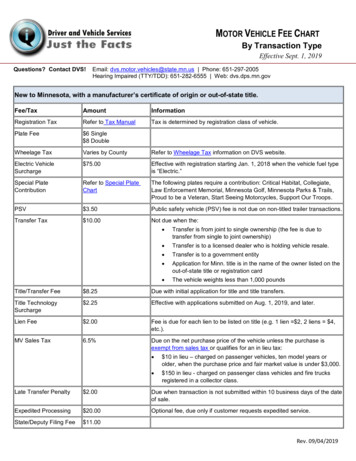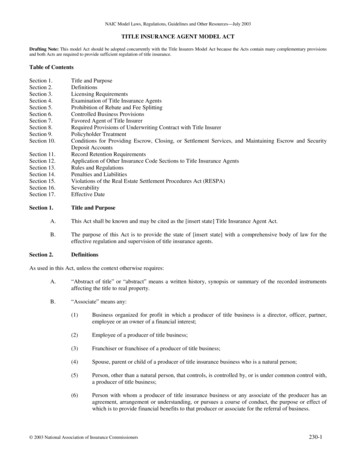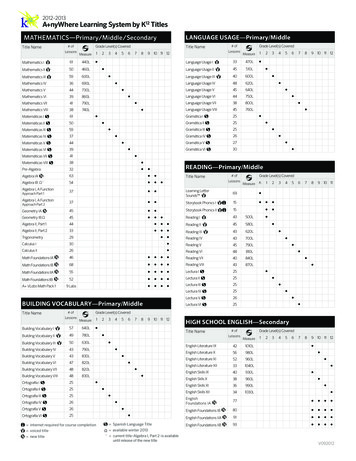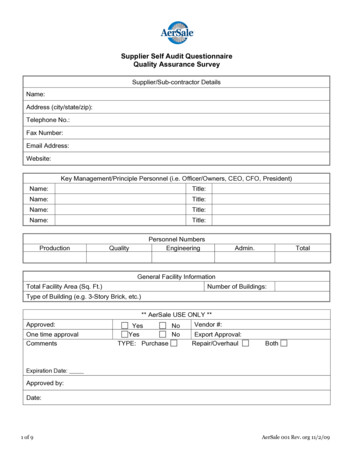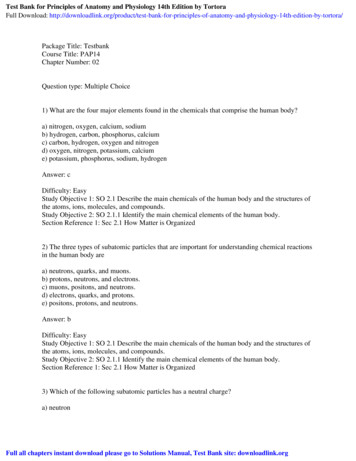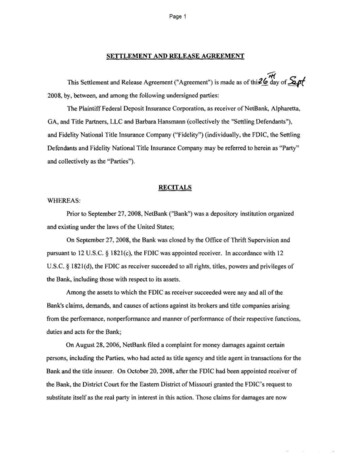
Transcription
Author:Title:Baral, PranayaImplementation of 5S methodology on slot line assembly for aManufacturing Company located in MinnesotaThe accompanying research report is submitted to the University of Wisconsin-Stout,Graduate School in partial completion of the requirements for theGraduate Degree/ Major:Research Adviser:Ned WeckmuellerSubmission Term/Year:Number of Pages:MS Technology ManagementFall, 201238Style Manual Used: American Psychological Association, 6th editionI understand that this research report must be officially approved by the Graduate School andthat an electronic copy of the approved version will be made available through the UniversityLibrary websiteI attest that the research report is my original work (that any copyrightable materials have beenused with the permission of the original authors), and as such, it is automatically protected by thelaws, rules, and regulations of the U.S. Copyright Office.My research adviser has approved the content and quality of this paper.STUDENT:NAME Pranaya BaralDATE: 12/18/2012ADVISER: (Committee Chair if MS Plan A or EdS Thesis or Field Project/Problem):NAME Ned Weckmuller DATE: --------------------------------------This section for MS Plan A Thesis or EdS Thesis/Field Project papers onlyCommittee members (other than your adviser who is listed in the section above)1. CMTE MEMBER’S NAME:DATE:2. CMTE MEMBER’S NAME:DATE:3. CMTE MEMBER’S --------------------------------------This section to be completed by the Graduate SchoolThis final research report has been approved by the Graduate School.Director, Office of Graduate Studies:DATE:
1Baral, Pranaya. Implementation of 5S methodology on slot line assembly for aManufacturing Company located in MinnesotaAbstractOne of the most common practices carried in modern manufacturing facilities is theimplementation of 5S philosophy. 5S, Japanese improvement ideology, is a lean manufacturingtool directed at improving the overall efficiency and consistency. This particular project studywas carried by the author during his internship with XYZ company. The study was based on amoving assembly line. Due to increase in volume of cabs in recent year, the work stations werenot fully organized as desired, resulting in loss of productivity, time, and quality to some extent.This research study was aimed at improving the assembly line flow by using effective andefficient lean manufacturing tools (5S in particular), thereby resulting in increased productivity,run time, quality, and adapting to the 5S culture as a means for continuous process improvement.The paper covers the results and documents them in form of pictures, accesses the results, andalso suggest necessary recommendations based on the findings for a continuous improvementcycle.
2AcknowledgmentsI would like to thank my mentor and research advisor, Mr. Ned Weckmueller forhis valuable support, unchallenging suggestions, and constant motivation throughout thisproject study. Also, I would like to thank company XYZ for providing me a platform toutilize my knowledge, skills, education for a pragmatic industrial exposure. I would alsolike to mention my program director, Dr. James Keyes, who has always been positive,helpful, and humble.I would also like to thank University of Wisconsin-Stout for allowing me to pursemy graduate studies. Last but not the least; I would like to dedicate this degree to myparents who have always been pillar of strength throughout my life, and supporting me inmy endeavors.
3Table of Contents. PageAbstract .1List of Figures .6Chapter I: Introduction .7Statement of the Problem .7Purpose of the Study .8Assumptions of the Study .8Definition of Terms.8Limitations of the Study.10Methodology .10Chapter II: Literature Review .11Lean Manufacturing : An Overview .11Key Concepts in Lean .13Waste Elimination.13Continuous Improvement.14Just in time (JIT) .14Product Smoothing .14Standardization of Work .15Total Preventive Maintenance (TPM) .15Other Waste Reduction Methods .165S .17Seri .17
4Seiton .18Seiso .18Seiketsu .18Shitsuke .19Benefits of 5S .195S as Culture .19Chapter III: Methodology .21Perform 1-S (Sort).21Perform 2-S (Set in Order) .22Perform 3-S (Shine) .23Perform 4-S (Standardize) .23Perform 5-S (Sustain) .24Limitations .24Chapter IV: Results .26Introduction .26Visual Management System .26Red Tagging Strategy .29Organization of work station .30Cleanliness of work station .33Auditing 5S process for continuous improvement.34Summary .34Chapter V: Discussion .35Limitations .35
5Recommendations .36Conclusions .36References .37Appendix A: 5S Observation Sheet .38
6List of FiguresFigure 1: QDIP Board.27Figure 2: Cell Daily Management Board .28Figure 3: Unneeded Item Log List .29Figure 4: Red Tag Area Board .30Figure 5: Rework Station .31Figure 6: Fixture Station .32Figure 7: Cleaning Supply Shadow Board.33Figure 8: Trash Bin .33
7Chapter I: IntroductionIn today’s world the importance of Lean Manufacturing principles in industrialsector can’t be ignored. The global market is becoming competitive and customers aredemanding more than ever. Companies mainly focus on reducing the cost and improving theproductivity & quality through continuous improvement. One of the most common practicescarried in modern manufacturing facilities is the implementation of 5S philosophy. 5S is a leanmanufacturing tool directed at improving the overall efficiency & consistency of theprocess/place/service by eradicating unwanted waste. Originally pioneered by the Japanese, 5Sis an abbreviation for “Seiri” (Sort), “Sheton” (Set in order), “Seiso” (Shine), “Seiketsu”(Standardize), and “Shitsuke” (Sustain).Company XYZ is one of the leading providers of steel cabs in North America and rollover protective structures (ROPS) for original equipment manufacturers (OEM) such as JohnDeere and Caterpillar. It offers world class metal fabrication, cutting-edge robotic welding,high-level paint finishes, and value-added assembly. It has two facilities totaling 43 acresenclosing more than 600,000 square feet. Both sites utilize the latest in modern manufacturingenvironment backed by expert service, quality driven culture, and on time delivery.Statement of the ProblemThe problem situation is based on the slot line assembly. Slot line is basically a movingconveyor assembly line for cabs. The line covers around 70% of the total manufactured cabs inthe plant. There are 14 stations in total with over 25 employees working during a regular shift.The increase in volume of the cabs (currently 50 per day) in recent years resulted in moving cabson the slot line. Due to this, each station is not as fully organized as it was supposed to be,resulting in loss of time, productivity, and also quality to some extent.
8Purpose of the StudyThe purpose of this research project is to focus on improving the assembly line flow byusing effective and efficient lean manufacturing tools (5S in particular), thereby resulting inincreased productivity, run time, quality, and adapting to the 5S culture as a means forcontinuous process improvement.Assumptions of the Study1. The project was planned, supported, and well executed under the guidance provided byupper level management.2. All the associates and personnel involved in this project were educated about theobjectives, basic guidelines, principles, barriers, and other related information pertainingto its successful implementation.3. The output on implementation of the project was followed up on regular basis andloopholes were communicated as a basis for continuous process improvement.Definition of Terms5S. A method commonly used by a manufacturing company to achieve an effective,efficient, and organized work environment, so as to boost productivity, reduce cost, and improvequality standards.Heijunka. A concept introduced by Toyota Production System (TPS) meaning productor service smoothing.Just in Time (JIT). A concept that helps to reduce the inventory level and carrying cost.Kaizen. A term coined in Japanese language emphasizing continuous processimprovement.
9Kanban. Also a Japanese term, it basically refers to signals between different points invarious processes.Lean. A Japanese philosophy that focuses on achieving high productivity, low cost, andimproved quality.Muda. Japanese term for waste.Mura. Japanese term for unevenness.Poka - Yoke. A Japanese term for a defect control system focusing on inspection ofevery part to insure zero defects.Seiri. Segregate what is needed and what is not needed in the work place. Confirm andinvolve everyone that the items sorted are not needed for performing a particular job in that workstation before getting rid of them.Seiton. Clearly mark and organize all the needed items as per use in an effort toeliminate the waste.Seiso. Cleaning and inspecting work areas to ensure a clean and safe environment.Seiketsu. Create proper methods and procedures that guarantees all the above 3 steps(Seiri, Sheton, and Seiso) happen on a daily basis.Shitsuke. Continuous process improvement for achieving a discipline to properlymanage the 5S principle.Total Productive Maintenance (TPM). A key concept used in lean for improvingmachine availability through proper maintenance and production resources.Total Quality Maintenance (TQM). A management concept developed by W. EdwardsDeming for successful implementation of business processes.
10Toyota Production System (TPS). A lean management philosophy developed byJapanese company Toyota.Limitations of the StudyThis project study was carried by the author while working as an intern for the CompanyXYZ from Jan 2011 to Dec 2011. This project was limited to only one moving assembly line onthe plant floor. The implementation of the same process in other areas of the plant was notcovered under the scope of study. The same process might not be recommended for any othermoving assembly line as there were many variables that might alter the output of the project.However, recommendations for continuous improvements were provided within the scope ofstudy.MethodologyThe plan was to focus on the major objectives of increasing productivity, lowering cost,and improving overall quality standards. The key was to work closely with the associates andpersonnel, so that they would develop an overall understanding of the process, would be able togather necessary details and information, and become acquainted with the 5S culture. Theorderly implementation of the 5S ideology and its proper follow up were critical for thecontinuous process improvement. This project study was successful in applying the leanmethodologies and principles to pragmatic effect with great efficiency, thereby organizing theworkplace for higher productivity, customer satisfaction, and sustainability.
11Chapter II: Literature ReviewThis chapter basically covers the general literature review for the lean manufacturing and5S philosophy. The purpose of this portion of study is to familiarize the readers with leanmanufacturing, the key concepts used in lean, the philosophy of 5S & its importance, and 5S asculture.Lean Manufacturing: An OverviewManufacturing companies have always strived to improve their productivity and thequality of their products in order to be sustainable in today’s competitive market. Globalizationof the market and the rise of merger companies have made it even tougher to prevail in themarket. In such cases, correct strategies to make the manufacturing line more efficient andproduce higher quality product become crucial. Amongst various methodologies to improve theproduction line, the Japanese improvement ideology of lean manufacturing is the most provenand widely accepted.Today, a lot of manufacturing companies are implementing thisphilosophy for better productivity and quality.The concept of lean principles was derived from the Japanese manufacturing industry(Jones, 2003). The term lean manufacturing was first coined by John Krafcik in his articleentitled “Triumph of the Lean Production System” in 1988 which was based on his master’sthesis at MIT (Krafcik, 1988) and the concept has not been limited to Japanese industries but hasbeen accepted and implemented all over the world. Toyota, the Japanese automobile company,has been considered as the initial promoter of the lean manufacturing philosophy which evolvedfrom the experiences during the end of 1930’s. After the Second World War Toyota and otherJapanese companies had to go through a very hard time since they had very limited resources torebuild their industry. Most Japanese companies resorted to western industries for ideas and
12inspiration to rejuvenate their industries (Jones, 1990). Since US companies had to address avery large market after the end of World War II, they put their efforts into mass production tomeet the consumers’ demand. On the other hand, Japan had a very small market and investmentcapital was also very scarce. With very limited resources and production demand, there was aneed to develop an efficient manufacturing system which was flexible and used fewer resources.In this situation, the genius executive of Toyota, Taiichi Ohno, developed the concept whichfundamentally focused on preserving value with less work and resource which was later coinedas lean production in the 1990’s. Since it was derived mostly from the Toyota ProductionSystem (TPS), it is also often referred to as Toyotism (Jones, 1990). This concept is basicallyfocused on reducing/eliminating wastes (muda) and improving the flow or smoothness or work,thereby steadily eliminating unevenness (mura) through the system.In the 1980’s, western automotive companies began to realize that the Japanesemanufacturing concept was far better than theirs in terms of productivity, quality, and resourceutilization.Hence, an intensive research study called “The International Motor VehicleProgram” (IMVP) was carried out by Womack, Jones and Roos at Massachusetts Institute ofTechnology to investigate the Japanese automotive industry and compare it with westernautomotive industries. IMVP deduced significant difference in productivity and quality betweenthese two cultures. The concept applied by the Japanese companies to remain superior in themarket was then termed as lean production in IMVP research (Egglestone, 1994). The IMVPreport is well recognized all over the world in the famous book entitled “The Machine thatChanged the World” (Jones, 1990).
13Key Concepts in LeanLean Manufacturing is of great interest to manufacturing companies from all around theworld.Today many companies are applying the lean manufacturing concept to achieve asubstantial competitive advantage by improving quality, productivity, customer service, andprofitability. Lean manufacturing is a production philosophy. It is a method of mapping theoverall manufacturing process from raw material to finished goods delivered to the customers. Itis termed “lean” because these principles help manufacturers to produce “more” with “less”- lesstime, less inventory, less capital, and fewer resources. Lean accomplishes this by focusing thechanges required to streamline the overall production process by identifying and eliminating anywaste (muda) in the process.The concept of lean manufacturing can be summarized in the following categories.Waste EliminationWastes are the activities that do not add any value to the product. There are basicallyseven types of wastes in the lean manufacturing concept. They are:1. Transportation: movement of materials which add no value to the product.2. Inventory: any material or work on hand other than what’s needed right now to satisfycustomer demand.3. Motion: any movement of people that does not add value to the product. Thisincludes walking and reaching.4. Waiting: time spent waiting during the processes.5. Over Production: when more products are produced than customer demand.6. Over processing: when something uses more resources such as space, energy, time orpeople than required.
147. Defects: work that is less than the desired quality level (Jones, 2003).All of these activities add cost, but no value to the products. Controlling and eliminating thesewastes leads to more efficient work.Continuous ImprovementContinuous improvement is another important principle of lean manufacturing. It is oftenreferred to by the Japanese word “Kaizen” which means change for good. Thus, Kaizen is acontinuous effort for perfection. Kaizen has become popular all over the world as a successfulconcept behind good management. The concept of Kaizen is summarized by the 5S principles.The 5S principles will be later discussed in this section.Just-In-Time (JIT)Just-in-time (JIT) is a concept that helps to reduce inventory and related carrying cost.JIT relies on signals which are termed as “Kanban” in Japanese. Kanban is basically the signalsbetween different points in various processes. These signals help to notify when to produce thenext part. Kanban are usually in form of tickets, however simple visual signals are also oftenused. JIT, if implemented properly, can significantly improve a manufacturing organization’sefficiency, quality of work, and eventually, profit. In short, Just-in-Time focuses on having theright material, at the right time, at the right place, in the right amount (Monden, 1998).Product SmoothingProduct Smoothing is another lean manufacturing tool. The Japanese term used forproduct smoothing is “Heijunka”. Product smoothing means trying to keep the production levelas consistent as possible each day (Jones, 1990). Heijunka is a concept introduced in ToyotaProduction system (TPS) which suggests that the production should not exceed the demand tosave cost. To accomplish this concept, the scheduling should be made smooth and effective to
15produce the right quantities of product and utilize resources wisely. If the production level is notconsistent, it results in waste and ultimately, loss of the company.Standardization of WorkStandardization of the work is a very important part in any organization as it helps tosmoothen the work and reduce waste. Standardization of works helps to confirm that every jobis well organized and is accomplished in the most efficient manner. It helps to maintain thequality of the job regardless of the person or group performing the job. If every worker followsthe same processing steps to do a particular kind of job, the same result can be achieved everytime, which results in consistent quality and better reduction of waste. Standardized proceduresmay include order of the working steps, job accomplishment time, and parts on hand. Followingthe standardized work, an organization can assure that line balancing is achieved, inventory isminimized, and wastes are reduced.Total Productive Maintenance (TPM)Total Productive Maintenance (TPM) is a very important aspect of lean manufacturing.It is a method of improving machine availability via better utilization of maintenance andproduction resources. It is basically an extension of Total Quality Maintenance (TQM). Themain objective of TPM is to maintain the machines in good condition and thus reduce downtime.Downtimes are usually caused by machine breakdown, incorrect use, and maintenance. Theuncertainty in uptime results in the necessity of keeping extra stocks and thus increases cost.TPM has the unique concept of tackling this issue. Unlike other production setups, TPMconsiders even operators as members of the maintenance team. The operators are trained toperform general maintenance tasks and simple troubleshooting. Further, technical teams with
16experts are also designated for advance maintenance. Introducing general troubleshooting of themachines to operators decreases downtime, thus improving production and profit.The three main components of TPM are preventive maintenance, corrective maintenance,and maintenance prevention. Preventive maintenance accounts for regular planned maintenanceof all the equipment as well as random check ups. Preventive maintenance helps to avoid suddenbreak down of the machines (Fled, 2000).Corrective maintenance accounts for the decision of whether to fix a down machine or to buya new one. If a machine is very unreliable on uptimes, then it is always better to buy new one.Sometimes replacing only the important parts/components can also solve the problem.Maintenance prevention accounts for buying the right machine. If the machine is hard tocomprehend for the operator and maintenance person, then it can adversely affect the productionline.Other Waste Reduction Methods Other lean manufacturing waste reduction tools include zero defects, setup reduction, andline balancing. The zeros defect concept ensures that the products are defect free and quality isimproved continuously (Karlsson, 1996). One of such zero defects concepts is poka-yoke.Poka-yoke is a defect control system that inspects every part to make sure that there are zerodefects. The main objective of poka-yoke is to point out the defective parts at the source, detectthe cause of the defect, and prevent the defective part from moving to the next work station(Fled, 2000).Setup reduction is another tool to reduce waste. It basically accounts for reducing thetime required to change the setup in a machine. There are two types of setups: internal andexternal setup. Internal setups are those setups that can be done only when machine is stopped
17and external setups are those setups which can be done even when the machine is running. Thebasic idea of setup reduction is to reduce the internal activities and replace them with externalactivities if possible which helps in speedy operations.The other waste reduction tool, line balancing is also one of the most efficient tools intackling wastes. The idea of line balancing is to balance the work between each workstation andmove the correctly worked part to the downstream workstation as soon as possible. This helps increating a smooth synchronized production line without any stoppage.5S5S is one of the most widely used lean tools. 5S was introduced by Hiroyuki Hiranowithin an overall approach to production systems. It is a methodology that uses five Japanesewords to organize a workplace. These five Japanese words are seiri, seiton, seiso, seiketsu, andshitsuke which mean tidiness, orderliness, cleanliness, standardization, and disciplinerespectively. However to preserve the 5S concept some term them as sort, set, shine, standardizeand sustain. These words basically describe how a workplace can be made smooth, disciplined,clean, and impressive. The 5S concept can be applied to any workplace in the service sector,manufacturing units, and normal offices. 5S was brought forward to enable ‘Just in TimeManufacturing’. Later IMVP research suggested that the term ‘Just in Time’ was inappropriatesince the success of Japanese companies was built upon far more than time factor alone (Jones,1990).SeiriSeiri is first ‘S’ of the 5S processes.It refers to getting rid of all the unwanted,unnecessary, and unrelated material from the workplace and thus prioritizing the requirements,and keeping only the most essential items at easily accessible places. The unnecessary items are
18either stored or discarded as per their degree of importance. Furthermore, it tries to reduce eventhe necessary items to a minimum level. Seiri helps in simplification of tasks, effective use ofspace, and wise purchase of items.SeitonThe second ‘S’, Seiton, accounts for orderliness. By orderliness, it means right things atright place. The concept behind seiton is that every item should have a proper designated plac
Toyota Production System (TPS). A lean management philosophy developed by Japanese company Toyota. Limitations of the Study This project study was carried by the author while working as an intern for the Company XYZ from Jan 2011 to Dec 2011. This project was lim

